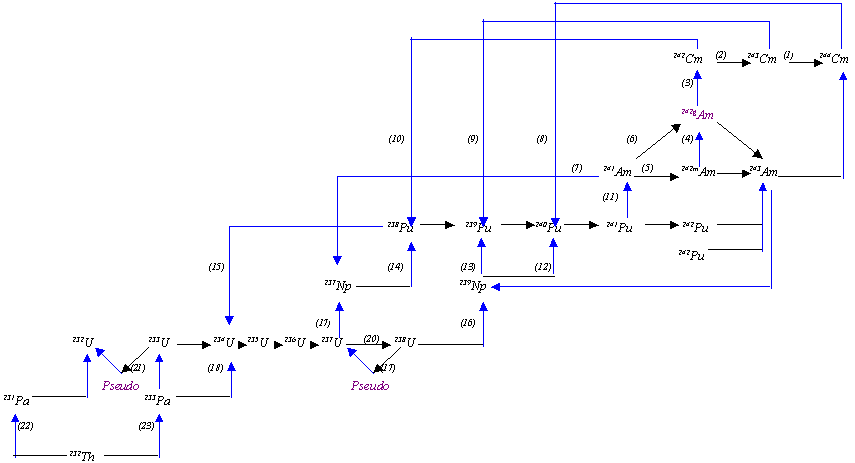|
Notes:
(1) Direct capture in Cm-243 yields
Cm-244.
(2) Direct capture in Cm-242 yields
Cm-243.
(3) Beta decay of Am-242 yields
Cm-242.
Branching ratio (BCm2 =
82.7%) is accounted for by an effective (reduced) concentration of Am-242,
which
is treated as a fission product (i.e. it has no fission cross section).
The positron emission branch
producing Pu-242 is ignored.
(4) Am-242m decays by isomeric
transition into Am-242. The concept of a reduced 242Am concentration
can
not be implemented for the production by
the decay of Am-242m because a yield for decay can not be
specified in the WIMS-D library.
(5) Capture in Am-241 results
in Am-242m with a branching ratio BAm2. The branching
ratio is energy
dependent. Calculations based on ENDF/B-VI
Rev.5 data produce values ranging from 0.132 for the
Plutonium recycling benchmark to 0.109
for the BAPL-2 benchmark. A value (BAm2 =0.12) is retained
as in the 1986 WIMS-D library. It
approximately corresponds to the DIMPLE-S01 benchmark.
(6) Reduced Am-242
is produced from capture in Am-241. Since only one nuclide
can be specified as the
capture product (and this is Am-242m
under the previous item), Am-242 is treated as a fission product
with the yield proportional to the capture
to fission (c/f) ratio. Unfortunately the ratio strongly depends
on the neutron spectrum. Calculations
based on ENDF/B-VI Rev.5 data produce c/f ratios ranging from
42 for the Plutonium recycling benchmark
to 124 for the BAPL-2 benchmark. A value (c/f = 92) is adopted,
which approximately corresponds to the
DIMPLE-S01 benchmark. The expression for the reduced yield of
Am-242 is given by:
(c/f)*(1
BAm2)*BCm2
The fission in Am-241 is predominantly
a threshold reaction with a small subthreshold contribution. From
the reactivity point of view the fission
in Am-241 is not important. To make the yield of Am-242g exact,
the
fission cross section of Am-241 in the
WIMS-D library is forced to be proportional to the absorption cross
section, normalised to conserve the above selected
c/f ratio. The effective reduced 242Am yield is 67 atoms
per fission, based on the same data for
BCm2 and BAm2 as for items (3) and (5), respectively.
(7) Am-241 decays by alpha emission
into Np-237.
(8) Cm decays by alpha emission
into Pu-240.
(9) Cm decays by alpha emission
into Pu-239.
(10) Cm-242 decays by alpha emission
into Pu-238.
(11) Pu-241 decays by beta emission
into Am-241.
(12) On capture in Np-239 the
resulting Np-240 is assumed to decay instantly by beta emission into Pu-240.
(13) Np-239 decays by beta
emission into Pu-239.
(14) On capture in Np-237 the resulting
Np-238 is assumed to decay instantly by beta emission into Pu-238.
(15) Pu-238 decays by alpha emission
into U-234.
(16) On capture in U-238 the resulting
U-239 is assumed to decay instantly by beta emission into Np-239.
(17) To account for the production
U-237 from the (n,2n) reaction of U-238, a pseudo fission product
(ID=4927) is defined, which decays
instantly into U-237. The yield is equal to the ratio of (n,2n)/(n,f)
reactions of U-238. This ratio is
sensitive to the detailed shape of the spectrum and hence difficult
to determine. The reaction contribution
above 10 MeV is significant. The value for the yield per fission
(n,2n)/(n,f) =0.06 is adopted.
(18) The capture product of Pa-233 is assumed to decay instantly into
U-234.
(19)U-237 decays by beta emission into Np-237.
(20) The capture chain from U-232 up to U-238 is represented explicitly.
(21) To account for the production U-232 from the (n,2n) reaction in U-233,
a pseudo fission product
(ID=4927) is defined, which decays
instantly into U-232. The yield is equal to the ratio of (n,2n)/(n,f)
reactions.
(22) To account for the production U-232, the fission product Pa-231 is
introduced (i.e. the fission cross
section is deleted from the cross
section set). Its fission yield is equal to the ratio of (n,2n)/(n,f)
reactions of Th-232. The capture
product of Pa-231 is assumed to decay instantly into U-232.
(23) The capture product of Th-232 is assumed to decay instantly into
Pa-233.
|



